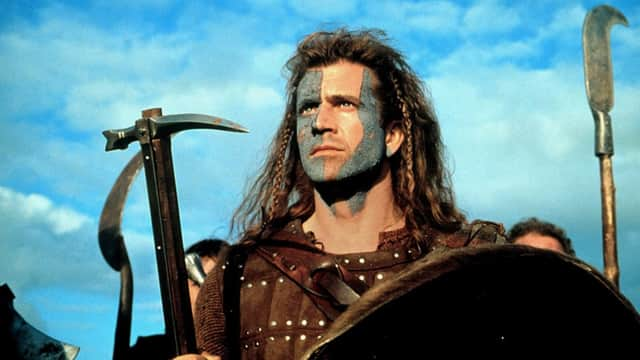10 historical innaccuracies in Braveheart as film turns 25


“And the winner is… Braveheart.”
Twenty-four years ago Mel Gibson’s account of Scotland folk hero William Wallace scooped up Best Picture award at the 68th Academy Awards, a year on from its release in 1995.
For all the plaudits and legions of fans, Braveheart has always had its detractors – particularly among history scholars.
Advertisement
Hide AdAdvertisement
Hide AdAuthor John O’Farrell, wrote in his book An Utterly Impartial History of Britain, claimed that the film couldn’t have been more inaccurate if a plasticine dog was added to the cast and the film was retitled William Wallace and Gromit.
Though O’Farrell’s claim is on the harsh side, the film is littered with historical inaccuracies – here are some of the most blatant.
Jus Primae Noctis
In the film’s opening act Edward Longshanks is seen invoking Kus primae Noctis, a medieval legal right which allowed nobles to have sexual relations with subordinate women on their wedding nights.
There is however debate over the existence of the law, with medieval scholar Albrecht Classen claiming “practically all writers who make any such claims [of its existence] have never been able or willing to cite any trustworthy source, if they have any.”
Battle of Stirling Bridge
Advertisement
Hide AdAdvertisement
Hide AdIn Braveheart the Battle of Stirling Bridge, one of Wallace’s forces most momentous victories, is missing two key elements: rebellion leader Andrew de Moray and, perhaps more crucially, the bridge.
Despite this the scene has gone down in film history as one of the best depictions of brutal medieval warfare, with CNN listing it as one of the best battles in cinema history.
The real Braveheart
The title itself has been tarred with the label of historically false.
The “Brave Heart” is a title used to described Robert the Bruce
Advertisement
Hide AdAdvertisement
Hide AdBruce’s right hand man Sir James Douglas allegedly coined the name during a battle with Saracens en-rout to the holy land. Carrying the heart of his friend, Sir James is purported to have thrown the organ into battle and shouted “Lead on Braveheart, as thou dost!”
The heart was recovered and is said to be buried at Melrose Abbey.
Wallace’s father
Wallace’s father’s name was Alan Wallace, not Malcolm, and he would not have been killed when Wallace was a boy, according to historian Gary Stewart.
In fact, Stewart suggest that William’s father, who was portrayed as being killed and hanged by English occupiers in Braveheart, was likely alive during his son's rebellion.
What about his uncle?
Advertisement
Hide AdAdvertisement
Hide AdUncle Argyle, portrayed by Brian Cox, was also a complete work of fiction.
Gary Stewart writing for the Scotsman notes that “an uncle or two may have indeed helped educate William as a boy.”
Hero or villain
Wallace is portrayed as a just hero from humble highland beginnings in Braveheart, but historians are in agreement that Wallace was from noble lowland stock.
Author Christ Ganitz wrote of his portrayal in Braveheart: "any hint of his descent from the lowland gentry (i.e., the lesser nobility) is erased, and he is presented as an economically and politically marginalized Highlander and 'a farmer'—as one with the common peasant, and with a strong spiritual connection to the land which he is destined to liberate."
Isabella of France
Advertisement
Hide AdAdvertisement
Hide AdWilliam is shown to have romantic relations with Isabella of France, the wife of Edward II. Later in the film it is implied that the future Queen of England is carrying the child of Wallace
In reality, the pair likely never met.
In the film their affair is shown to take place after the Battle of Falkirk, but at this time the real Isabella would have been just three years old and living in France.
Face paint and tartan
Images of Mel Gibson’s face caked in blue paint have become iconic – but scholars have been quick to point out that such war paint wasn’t in use at this time.
Nor was tartan which enjoyed a liberal outing in the 1995 film.
Advertisement
Hide AdAdvertisement
Hide AdScottish author Peter traquair described Braveheart’s costume faux pas as a "farcical representation” of Wallace, noting that the folk hero was not “a wild and hairy highlander painted with woad (1,000 years too late) running amok in a tartan kilt (500 years too early).”
Weapon use
Wallace is seen wielding a two-handed claymore in Braveheart, but in reality a sword and shield would have been a more accurate setup for a warrior of this era, according to Youtube historian scholagladiatoria.
Two-handed swords came into common use in the 16th century.
Edward’s death
The film reaches its climax with the deaths of William Wallace at the gallows and King Edward I on his deathbed.
Though Wallace’s death is somewhat accurate, in reality Longshanks died some two years after Wallace’s brutal ending.
He died on his way north to deal with the “troublesome Scots”.